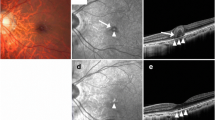Abstract
Introduction
New diagnostic tools such as the retinal thickness analyzer (RTA), optical coherence tomography (OCT), and topographic angiography (TAG) were introduced into clinical ophthalmology during the last years giving the examiner new insights into anatomical and functional aspects of macular disease. In this study, advantages and disadvantages of the new imaging methods have been evaluated in patients with serous (sPED) and fibrovascular pigment epithelial detachments (fPED) secondary to age-related macular degeneration (AMD).
Methods
TAG, using fluorescein angiography (FA), provides a three-dimensional profile of the fluorescein pattern based on the analysis of a set of 32 confocal images over a depth of 4 mm. RTA and OCT provide cross-sectional images of the neurosensory retina and the retinal pigment epithelium–choriocapillary complex as well as retinal thickness data encoded in a false color map. We compared and evaluated these modalities in 15 patients with fPED and 15 patients with sPED secondary to AMD.
Results
In patients with classic fPED, TAG detected neovascular structures and delineated their configuration. In sPEDs, pooling of extravascular fluid was detected in a dome-shaped configuration. OCT provided detailed information on the neurosensory retina’s structures but failed to detect the neovascular membrane in fPED. Mapping the retinal thickness, RTA and OCT both failed to detect the PED and showed typical algorithm error-based patterns.
Conclusion
TAG OCT and RTA are useful imaging modalities in the evaluation of AMD cases. TAG visualizes the vascular configuration, dynamic perfusion, and leakage changes. OCT and RTA are able to complementarily document intra-, subretinal, and sub-RPE fluid accumulation secondary to CNV. However, OCT seems to be more efficient in imaging AMD-related pathologies than RTA, as this modality is often compromised by intra- or subretinal structural abnormalities. Nevertheless, all modalities may provide further valuable insight into AMD pathogenesis, enhance diagnostic quality, and improve the assessment of therapeutic effects.


Similar content being viewed by others
References
Blinder KJ, Bradley S, Bressler NM, Bressler SB, Donati G, Hao Y, Ma C, Menchini U, Miller J, Potter MJ, Pournaras C, Reaves A, Rosenfeld PJ, Strong HA, Stur M, Su XY, Virgili G; Treatment of Age-related Macular Degeneration with Photodynamic Therapy study group; Verteporfin in Photodynamic Therapy study group (2003) Effect of lesion size, visual acuity, and lesion composition on visual acuity change with and without verteporfin therapy for choroidal neovascularization secondary to age-related macular degeneration: TAP and VIP report no. 1. Am J Ophthalmol 136(3):407–418, Sep
Bressler NM, Arnold J, Benchaboune M, Blumenkranz MS, Fish GE, Gragoudas ES, Lewis H, Schmidt-Erfurth U, Slakter JS, Bressler SB, Manos K, Hao Y, Hayes L, Koester J, Reaves A, Strong HA; Treatment of Age-Related Macular Degeneration with Photodynamic Therapy (TAP) Study Group (2002) Verteporfin therapy of subfoveal choroidal neovascularization in patients with age-related macular degeneration: additional information regarding baseline lesion composition’s impact on vision outcomes-TAP report No. 3. Arch Ophthalmol (United States) 120(11):1443–1454, Nov
de castro E, Christini G, Martelli A et al (1987) Compensation of random eye motion in television ophthalmoscopy: preliminary results. IEE transmed Imaging 6:74–81
Fukuchi T, Takahashi K, Ida H, Sho K, Matsumura M (2001) Staging of idiopathic choroidal neovascularization by optical coherence tomography. Graefe’s Arch Clin Exp Ophthalmol 239:424–429
Koozekanani D, Roberts C, Katz SE, Herderick EE (2000) Intersession repeatability of macular thickness measurements with the Humphrey 2000 OCT. Invest Ophthalmol Vis Sci 41(6):1486–1491, Aug
Muscat S, Parks S, Kemp E, Keating D (2002) Repeatability and reproduceability of macular thickness measurements with the humphrey OCT system. Invest Ophthalmol Vis Sci 43:490–495, Aug
Pires I, Bernardes RC, Lobo CL, Soares MA, Cunha-Vaz JG (2002) Retinal thickness in eyes with mild nonproliferative retinopathy in patients with type 2 diabetes mellitus. Arch Ophthalmol 120:1301–1306, Aug
Polito A, Shah SM, Haller JA, Zimmer-Galler I, Zeimer R, Campochiaro PA, Vitale S (2002) Comparison between retinal thickness analyzer and optical coherence tomography for assessment of foveal thickness in eyes with macular disease. Am J Ophthalmol 134(2):240–251, Aug
Schaudig U (2001) Optische Kohärenztomographie. Ophthalmologe 98:26–34 ©Springer Berlin Heidelberg New York 2001, Aug
Schmidt-Erfurth U, Michels S, Barbazetto I et al (2002) Photodynamic effects on choroidal neovascularization and physiological choroid. Invest Ophthalmol Vis Sci (United States) 43(3):830–841, Mar
Schmidt-Erfurth U, Noack J, Teschner S, Birngruber R (1999) Confocal indocyanine green angiography with 3–dimensional topography. Results in choroid neovascularization (CNV). Ophthalmologe 96(12):797–804, Dec
Schmidt-Erfurth U, Teschner S, Noack J, Birngruber R (2001) Three-dimensional topographic angiography in chorioretinal vascular disease. Invest Ophthalmol Vis Sci 42(10):2386–2394, Sep
Seddon JH (2001) Epidemiology of age-related macular degeneration. In: Ryan S, Schachat AP (eds) Retina, Bd 2: Medical Retina, 3rd edn., Mosby Inc, St. Louis, Missouri, pp. 1039–1050
Sickenberg M (2001) Early detection, diagnosis and management of choroidal neovascularization in age-related macular degeneration: the role of ophthalmologists. Ophthalmologica (Switzerland) 215(4):247–253, Jul-Aug
Talia Technology (Talia Technology Ltd., Neve Ilan, Israel) User manual
Teschner S, Noack J, Birngruber R, Schmidt-Erfurth U (2003) Characterization of leakage activity in exudative chorioretinal disease with three-dimensional confocal angiography. Ophthalmology 110(4):687–697, Apr
Wormald R, Evans J, Smeeth L et al (2003) Photodynamic therapy for neovascular age-related macular degeneration. Cochrane Database Syst Rev (England) 2:CD002030
Zeimer R, Asrani S, Zou S, Quigley H, Jampel H (1998) Quantitative detection of glaucomatous damage at the posterior pole by retinal thickness mapping. A pilot study. Ophthalomology 105(2):224–231, Feb
Zeiss Humphrey Systems “Arbeitsweise des OCT 2” aus dem User Manual des OCT Modells 2010 Teilenummer 51390-2 REV.A Mai 2001 (User Manual)
Author information
Authors and Affiliations
Corresponding author
Rights and permissions
About this article
Cite this article
Ahlers, C., Michels, S., Beckendorf, A. et al. Three-dimensional imaging of pigment epithelial detachment in age-related macular degeneration using optical coherence tomography, retinal thickness analysis and topographic angiography. Graefe's Arch Clin Exp Ophthalmo 244, 1233–1239 (2006). https://doi.org/10.1007/s00417-006-0418-z
Received:
Revised:
Accepted:
Published:
Issue Date:
DOI: https://doi.org/10.1007/s00417-006-0418-z




